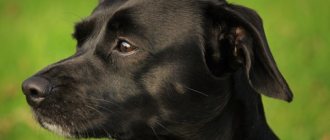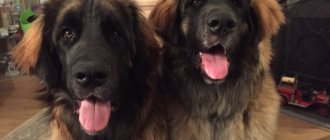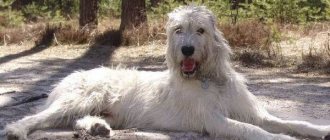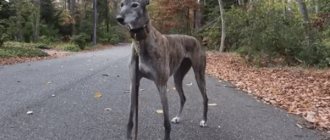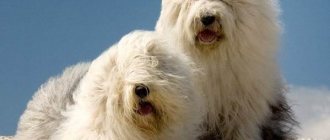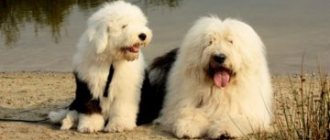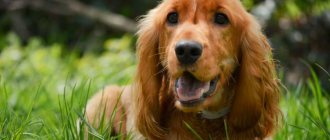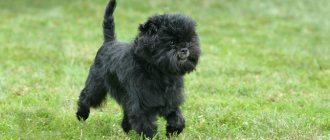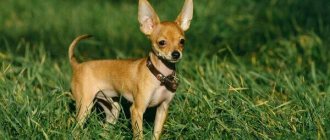Large types of hounds
Representatives of this species have substantial dimensions, which, as a rule, do not allow them to be kept in apartment conditions. They also need good physical activity; a regular walk in the park will not suit them. Often intolerant of other animals.
English Foxhound
This is a classic and the standard of a hunting dog. Brought out in the 16th century in Britain for noble people to hunt foxes on horseback; in other countries it was sometimes used for wild boars and deer. They usually work in a large pack, reaching speeds on rough terrain of up to 25 km/h.
Height at withers – 58-64 cm, body weight – 27-34 kg. This is an elegant dog with clear body lines. The skull is wide, square, with an elongated muzzle, ears are of medium length, drooping. The paws are high, the tail is raised up. The length of the coat is short, it is hard, of various colors, usually the white tone occupies up to 1/4 of the body.
The character is balanced, generally friendly, but wary of strangers. He is good with children and other animals, has intelligence and obedience. Suitable for a show career.
Bloodhound (Saint Hubert's dog)
A well-known breed of hound, many other varieties have evolved from it. The first mention of it dates back to the 10th century; for a long time, clergymen were engaged in selection.
This dog was used in hunting large game by the royal nobility, as well as for official and investigative work. It has an excellent sense of smell and can track prey following a trail five days old.
The dogs have a recognizable appearance - something between a mastiff and a basset hound, with a characteristic, slightly elongated body, a powerful head with folds on the muzzle, long ears and a bored look. Height at withers is 62-68 cm (adjusted in both directions by 4 cm), weight is 40-54 kg. The coat is short, smooth, often red in color, sometimes with tan.
The character is extremely balanced, absolutely non-aggressive. This is a majestic, slow, somewhat stubborn dog.
Russian hound
Originally Russian, an ancient breed, not yet recognized by the FCI. Mentioned as early as the 11th century, although the standard was adopted at the end of the 18th. It is used for hunting hare, fox, wolf, and less often wild boar and bear. Usually used in a pack, can follow a blood trail.
Height at withers – 56-68 cm, weight about 30 kg. The physique is strong, muscular, somewhat reminiscent of a wolf. The head is oblong, wedge-shaped, ears are “envelope”. The coat with undercoat is short, with a transition on the body to a longer one, a “mane” is characteristic. The color is black-backed, without clear boundaries, purple or grayish, with white markings on the paws and chest.
The character is flexible, non-aggressive, but shows a tendency to dominate. She is calm towards dogs, does not like other animals.
Black and tan coonhound
Another name is the American Coon Hound. The only Coonhound recognized by the FCI. The breed was bred to hunt raccoons, as well as large game (deer, puma, bear). As a rule, they work in packs in difficult conditions (swamps, rivers, thickets of forest).
Height at the withers is 58-65.5 cm, weight – 32-40 kg. These are tall-legged, graceful dogs with an elongated head and a muzzle with developed wings. The ears are long and folded. The coat is short, smooth and shiny, black and tan.
The Coonhound is a dog with an independent character, somewhat stubborn, distrustful of strangers, and can be a watchman. Able to tolerate other dogs, but will hunt other animals.
Poitevin
A French hound bred in the 18th century to hunt wolves and roe deer. It is distinguished by its endurance, capable of working continuously for up to 20 hours. Suitable for hunting by blood trail. He has high speed qualities and fearlessness.
Height at the withers is 60-72 cm, weight is 27-33 kg. This is an elegant dog with high paws, a graceful athletic body and an elongated head. The ears are long, but shorter than those of other French hounds. The coat is short, black-white-red in color, sometimes there is no black in the color.
There are a large number of hound breeds, which allows you to choose the one that suits your appearance, character or “working animal”. When choosing a pet, you should take into account that animals of this group are hunters; they need an active life, with high physical and mental stress.
Origin story
European aristocrats loved to hunt predators (boar or wolf) with hounds. Gradually, large animals became extinct, so fox hunting became fashionable. Several breeds of hounds were bred in England, the most famous being the Foxhound and the Beagle (for pretentious hunting). The Foxhound was created by crossing Celtic hounds, terriers and, quite possibly, greyhounds. It is also called the fox hound. The dogs ran quickly, overcoming the obstacle, driving the fox out of the hole.
When North America was colonized by England, settlers brought the breed with them. The American climate is significantly different from English, so not all dogs survived. Those who remained adapted well to the new conditions and spread throughout the continent. Thanks to outbred crossing, other breeds appeared, in particular coonhounds (hounds used for hunting raccoons). They were bred in the 17th century by crossing the French hound and the English foxhound.
The Coonhound is a universal breed; the dog is taken to hunt raccoons, foxes, and bears. The breed was recognized by the United Kennel Club in 1905, and the American Kennel Club only in 2010.
Caring for Coonhounds
Caring for a Coonhound includes food, walking, maintenance and general care.
Food for a Coonhound should be high quality and balanced.
The basis is animal proteins (meat) - 75%, so if you feed your dog food, pay attention to the percentage of meat. The food must be at least super-premium class; you can choose one specialized for hunting breeds or active dogs
What common foods are suitable for a coonhound:
- Carnilove (whole line for dogs);
- Acana (entire line for dogs);
- Orijen (entire line for dogs);
- Summit for large breed dogs;
- AATU for dogs (very high meat content).
Meat is the basis of a dog’s diet
All these foods are gluten and grain free, with a lot of protein, their class is not lower than super-premium. The food is given according to the instructions on the packaging.
Natural food consists of lean meats, vegetables, and porridge. Some owners practice feeding only meat with a small addition of vegetables. This is also possible provided that the dog is given 100–150 g of low-fat cottage cheese per week and 3–4 raw eggs. Otherwise, calcium deficiency may occur. The amount of main food per day is calculated from the ratio of 40–45 g per 1 kg of dog weight.
When feeding natural food, it is a good idea to choose vitamin supplements (be sure to consult a veterinarian!).
The following should not be given to a Coonhound:
- food from the human table;
- spicy, fried, fatty foods;
- onions, garlic, potatoes, cereals, spices, seasonings;
- sweets (especially chocolate);
- pork and sea fish.
Food is the basis of a dog's health
You need to walk your coonhound at least 2 times a day for 1.5–2 hours. The walk should be active. You can optimally exercise your dog by teaching it to run next to a bicycle. But don’t forget that the dog not only needs to run, but also play with the owner and learn new things. Try, if possible, to change walking routes more often, so the dog will not get bored. It is best to keep a coonhound in a private house with a garden area. But a spacious apartment is also suitable, provided that the dog is walked a lot.
You don't need to wash your Coonhound more than 2-3 times a year. Short hair requires weekly brushing with a thick brush. Coonhound ears require special attention. They need to be examined more often so as not to miss an infection, the inner surface should be wiped daily with a napkin with a special lotion for cleaning dog ears, and the inside should be cleaned with it once every 5 days.
Since coonhounds, like all hunting breeds, love to roll around in something smelly (thus hiding their smell), frequent washing is necessary. My dog, although not a hunter, loves to give his owner “pleasant” surprises. But washing a dog with shampoo often is not very useful, so I found a very effective recipe from a breeder I know. You need to take clean sand and add a few drops of eucalyptus or lavender oil to it (not very much, just to remove the smell)
Okay, but gently rub the dog, leave for 5 minutes and rinse. Sand will remove all dirt, and oil will remove unpleasant odors.
It only helps those with short hair, because it is difficult to wash sand out of long hair.
Coonhounds, like all hunting dogs, love to roll around in odorous substances.
Description of the breed
There are several varieties of coonhound: red, blue speckled, black and tan, red speckled and Walker coonhound. The Red-Speckled Coonhound (another name is the English Coonhound) is a light and slender, hardy and strong dog. Height at the withers is 52-68 cm, weight up to 29 kg. The description is enshrined in the standard. The head is massive, elongated. The transition from forehead to muzzle is clearly pronounced. The ears are large and hanging. The eyes are medium-sized, widely set, dark in color. The body is square, slightly elongated, with well-developed muscles. The chest is wide, the back is straight. The tail is long and set low. The legs are straight and muscular, movements are easy.
The Redbone Coonhound (red dog) was bred in Georgia (USA) in the 19th century as a hunting dog (hunts in any terrain and in any weather). This is not only an excellent hunter, but also a companion. The dog is strong and swims well, as it has webbed paws. The eyes are large, the ears are long. The dog is active, smart, affectionate. Despite the fact that he gets along with children, he should not be left with children. Due to its highly developed hunting instinct, it is not recommended to keep it with other pets. The peculiarity of this species is that the redbone does not distinguish its own from strangers, so it will not make a watchman.
Colors and coat
Coonhounds have short, moderately coarse, and shiny fur. It shimmers beautifully in the sun. Doesn't shed much. The color is red-chestnut (red-speckled), there are white spots. Other colors are allowed: blue-speckled (blue), black, yellow, red, tri-color.
Character
Although the dog is a hound, it can be affectionate and treats all family members with tenderness. Devoted, strongly attached to family, loves children. Expresses his emotions violently. Loves to play and walk outdoors. It is patient with other pets, but can sometimes mistake them for prey. The character is independent, slightly aggressive, obedient, strong-willed. The peculiarity of the dog is that it behaves with restraint under any circumstances. He cannot stand it when his freedom is restricted, so it is not recommended to keep him at home all the time.
The Red Coonhound is a universal hunter, catches any animal (small and large animals), an attentive watchman, and a good companion. Active and energetic. Loves to run at high speed without rest and compete with other dogs. Brave, fearless, flexible and hardworking. He barks loudly, which may not please the neighbors.
The dog needs socialization, in this case it will behave friendly and politely with other people. Some representatives of the breed are shy and timid. They also need to undergo a socialization course.
Exterior
Raccoon dogs are large dogs with a square body and strong muscles. The height at the withers for males is 60 - 68 cm, for females 58 -65 cm, weight is 34-40 kg and 32 -37 kg, respectively.
These dogs have an elongated head with a clear transition from the forehead to the muzzle, despite this, the outlines of the head are very graceful. The nose is large, dark brown or black. Representatives of the breed are distinguished by highly developed jowls. The eyes are round and dark in color. The ears, located at eye level, are long and drooping in folds.
The neck is of medium length, smoothly turning into a straight, strong back, the chest is quite deep with convex ribs. The fore and hind limbs are strong and sinewy, parallel to each other. The paws are compact, rounded with strong black claws. The tail is long and thick, the dog holds it vertically or down.
Coonhounds are short-haired dogs, the coat is smooth, shiny and very thick. The color is only black with tan above the eyes; there may be stripes on the sides of the muzzle, on the chest, and on the paws.
Medium breeds of hounds
The group is compact in size with an energetic and fearless character. Many of them are suitable for city apartments, with a mandatory vigorous walking. They are quite peaceful, for the most part they can live in families with animals and children.
Norwegian Hound (Dunker)
It took shape at the beginning of the 19th century in Norway. The goal is to track the hare. Capable of finding prey, chasing it away and bringing it to its owner. Can work in hot and cold weather, in the snow. It is distinguished by persistent pursuit at not very high speeds.
Height – 47-55 cm at the withers, weight – 16-25 kg. The body is slightly elongated, the legs are high and muscular. The Dunker's ears are long, soft, rounded, and hang down. The coat is short, marbled blue and tan or tri-colored.
- This is a balanced and patient dog, rarely gets into fights, and is easy to train. However, she is somewhat independent in making decisions.
- Keeping it in a country house is recommended, with mandatory physical activity.
Porcelain hound (porselen or noble royal)
A rare breed, bred in France in the 15th century. It was almost destroyed during the French Revolution, but was later restored. It got its name due to its color and graceful appearance. It often walks in a pack and is used to herd hare, roe deer, and sometimes wild boar. May follow the trail of a wounded animal.
The height of the dogs is 53-58 cm at the withers, weight is 26-30 kg. Porselen has a proportional build, is elegant, and long-legged. The skull is broad, slightly elongated, and the ears have a pointed edge. The tail is thick, whip-like. The color is white, with red spots or specks.
At home he is a calm, kind, friendly dog, but on the hunt he is the embodiment of excitement and impulsiveness. Not for apartment conditions.
Harrier
Harriers are the basis of many breeds; England is considered its homeland. Selection was carried out to obtain dogs for riding hares, foxes, and sometimes wild boars. It is distinguished by its high-speed running, including over rough and mountainous terrain, its temperament and willfulness.
Height – 46-53 cm, body weight – 20-27 kg. The body is strong and stocky, the muzzle is elongated, pointed, with a flat skull. The ears are short in length and resemble the letter V. The tail is thick and raised up. The length of the coat is medium, it is not soft. Three-colored colors are more common, but all those characteristic of the species are acceptable. Requires persistent and long-term training.
Suitable as a family dog with the obligatory energetic walking, trips to nature, as well as jogging behind a bicycle or horse.
Estonian hound
A young breed, formed in the mid-20th century, when in Estonia there was a ban on hunting with dogs over 45 cm. Not officially registered by the FCI. Used for tracking hares, rabbits, foxes, and other small animals. Persistent, can keep a trace for up to 3 days.
The height of the animal is 42-52 cm, weight is 10-25 kg. Visually, Estonians resemble beagles. The body is stretched, the head is rounded, with an elongated muzzle. The ears are quite long, their tips are rounded. The height of the coat is small and hard. Black and piebald, less often brown or crimson piebald.
Dogs are affectionate, balanced, love children, and tolerant of other pets. Apartment housing is possible if there is high physical activity, but living in a house with a spacious enclosure is better suited.
Swiss Laufhund
One of the oldest breeds. Similar dogs existed in Ancient Egypt, then with Roman legionnaires they found their way to the Alps. They are the progenitor of many hounds. Bred for hunting hare and fox. Can also be used for baiting wild boar. They work well on the blood trail. Nowadays they are more often used in solo hunting on foot.
There are short-legged and long-legged varieties. The height at the withers of the former is 32-41 cm, weight – 14-18 kg, the latter – 46-59 cm and 16-23 kg.
- The Laufhund's body is elongated, its head is stretched, graceful, with a double chin. The ears are long and cone-shaped. The coat is short, harsh or smooth. The color is white, with large red or yellow spots.
- Laufhunds are distinguished by their absolute fearlessness, loyalty, and very high intelligence. They are wary of strangers and do not get along well with other animals. Not suitable for living in apartment conditions.
Division into groups
There are several classifications of dogs of this species, depending on the criterion that underlies the division.
For example, based on the number of simultaneously working animals, they are distinguished:
- Hounds working one at a time (example: Laufhund);
- Dogs performing in pairs or in a pack (example: Russian hounds, beagles, etc.).
By type of sequence there are:
- Dogs for complete (mountain hunting). Here the animals follow a pack of horses, and when they are brought close to the habitat of the prey (wolf, fox, etc.), they begin searching for it and racing together. The process stops when the prey reaches the gun or a group of greyhounds. A typical example is the English Foxhound.
- Dogs for hunting on foot. This includes dogs capable of working alone or with a partner. The dog must search for prey by following the scent, being far from the owner, follow it for a long time, up to several days, read the confused tracks, and notify the owner of his location with his voice. Examples: Basset Hound, Breton Griffon and Nivernes Griffon.
- Dogs for working on the blood trail. Hounds of this group are used to track wounded animals, usually ungulates. The dog must remain silent while following the blood trail; its voice is given only when it reaches its prey. Examples: Bloodhound, Estonian and Bavarian hounds, Poitevin.
There are also Western, Eastern and Brutish types of hounds. Dogs of the first option are distinguished by rounded ears, a powerful blunt muzzle, and short hair (for example, bloodhounds).
- Orientals have a flat wolf-type nose, a medium-length tail, narrow ears with a sharp angle, a muzzle and legs with short hair, and they also lack dewclaws (for example, Russian and Polish hounds).
- The busty type does not have a high running speed, but they are very durable. Dogs of this species are characterized by a short, rounded skull and smoothly rounded ears (for example, the Niverney griffon, Otterhound).
The most popular classification of this type is based on size. There are small, medium and large species.
Caring for a Coonhound
- The coat
can be brushed once a week as it is short. But when dogs change their coat, it is better to do the manipulation every day. It is advisable to do this outdoors, since the wool gets stuck into furniture and carpets and is then difficult to remove from there. The manipulation is carried out using special rubber brushes for short-haired dogs. Combs made of this material perfectly remove dead hair. Shampoo for bathing dogs with short hair, you need to buy a gentle one with a PH balance. Before washing, the concentrate must be diluted with water in a ratio of one to three. Try to wash your dog well to avoid skin irritation and dandruff. A wet dog needs to be thoroughly blotted with a terry towel. Next, place it in a warm, draft-free room and wait until it dries completely. - Claws
are trimmed regularly using nail clippers. Sometimes this is not required, since active pets move a lot and wear them down themselves. Watch only the dewclaws, as overgrown claws on them can get caught on everything, and this is dangerous. - Ears
that droop require more frequent grooming than other dogs. They can accumulate excess sulfur and dirt, and because of this they smell and are not properly ventilated. Therefore, to avoid chronic otitis and inflammation, they are cleaned regularly. This can be done using sulfur softening agents. The concentrate is injected into the ear, massaged and released for a while, and then simply blotted with a napkin. - The eyes
need to be examined after hunting. If dust or other foreign particles get in, wipe them off. When a more significant problem arises, take your pet to the veterinary clinic. - teeth
to be cleaned several times a week from childhood. In zoological stores you will find everything you need, specialized brushes and pastes. From time to time you can brush your pet's teeth with activated charcoal. It is moistened with water and rubbed on the dog’s teeth, and then all excess is wiped off with a soft cloth. - Feeding
of raccoon dogs is enhanced and strictly dosed. This means that the composition of the food must be complete, include the required amount of proteins, fats, carbohydrates, fiber, vitamins and minerals. Portions should not exceed the norm. Feed the dog at the same time after walking or hunting. If you cannot carefully choose a natural diet for your Coonhound, ready-made food will help you. They were carefully created by competent professionals, so that your four-legged friend will be in excellent condition. - Walks
for coonhounds that constantly need to be on the move must be long. The apartment is a prison for them. They love spacious backyards and fenced-in areas where they can run and frolic to their heart's content. And they simply adore walks in the forest, especially in the moonlight. Perhaps for some their barking will seem like music, but not for the neighbors - another proof that they cannot be kept in an apartment.
Description
A beautiful and graceful dog, which easily acquires many skills for rutting, completely obeys its owner. Ready to get along calmly with the family, and also lends itself well to training. Not at all aggressive towards people, but not averse to running after miniature animals. He loves children and games very much, and therefore tolerates boyish pranks at any cost.
Interesting fact
The species appeared in America; there are legends that the quadruped was introduced along with the first colonizers.
Interesting fact
Sometimes called the four-legged raccoon dog due to the fact that the hound is capable of chasing down a raccoon or other small mammal while hunting.
Interesting fact
Of all the coonhounds, only the black and tan was accepted by the International Canine Organization. The rest are recognized by the American Kennel Club.
Breed Features
This breed is famous for its acute sense of smell, almost the most outstanding in the world. It is interesting that the reason for such a sense of smell is not the nose, but the large hanging ears, which, like brooms, “sweep” odors towards the nostrils.
Hounds choose only one owner, but are devoted to each family member. It is difficult to get along with other pets as adults, so it is advisable to raise them together from an early age. But it gets along well with any dogs, as it has an innate instinct to work in a pack.
They will not vote without a reason, only in emergency situations. But they have strong “vocal abilities”, so the neighbors will not be delighted with her loud barking.
Main features:
- the hair is not afraid of various natural precipitations;
- slender square body;
- attentive sweet look.
Distinctive features
Head
The forehead is large, rounded with a noticeable transition to the front part. But the outline of the head retains its grace. The length of the bridge of the nose is equal to the width of the skull.
Jaws
Scissor bite, teeth are at the same level. Developed, large.
Eyes
Round, small, planted at an average distance. The look is wary, but not angry. A yellow iris is considered a defect.
Torso
Square in shape, the cervical region is muscular and has no folds. The back is straight and pumped. Massive chest, the depth of which reaches to the elbows.
Paws
Strong, with muscle relief. The hind legs are muscular and larger than the front legs. The fingers are gathered into a ball with a small bend.
Wool
Since the animal must be able to work in any weather conditions, the fur is very dense. Does not allow rain, snow, or wild wind to pass through. Has water-repellent qualities.
From the name of the breed it is easy to understand what color it is. The main color is charcoal black. There is tan on the eyebrows, chest, paws, belly and under the tail. White spots are not acceptable.
Character
The hound has a calm temperament and does not become annoying with its presence.
Appreciates people's attention, is reserved in society, and treats strangers coldly
It is undesirable to leave a cop alone for a long time, otherwise it may begin to howl and whine loudly. The American woman loves to play with children, but due to his impressive build, it is imperative to observe this process so that no misfortune occurs.
In critical situations, the hound is capable of making decisions. She loves sports and is able to make high jumps and move with powerful jerks. During a walk, you need to keep your pupil on a leash at all times, because the hunting instincts are very strong.
Historical reference
There is no reliable information about the origin of the breed, but there are a number of quite plausible assumptions. Hounds have always been popular in England. It is reliably known that English dogs were brought to America in the 18th century. The Foxhounds, famous throughout Great Britain, were the favorites of D. Washington and a symbol of the state, so their appearance on the new land was considered a kind of political move. A little later, hound dogs were brought to America from France.
The export of these dogs also had political overtones, emphasizing the loyal relationship between the British and the French. This is how, as a result of political gestures, two types of hounds ended up on the same territory, from which, according to the main version, the older, black and tan variety of coonhounds originated.
Today, all varieties of Coonhounds are considered rare breeds and are bred (mostly) only in America. In its homeland, this breed is popular because it is regularly used for its intended purpose - hunting raccoons.
Nutrition
- Like all dogs, Coonhounds are recommended to eat meat and meat products.
- Fish is also very good for them. You shouldn’t give river fish, it contains a large number of parasites, but you can safely feed sea fish. But for safety, it is recommended to remove large and sharp bones from the fish, which could cause a dog to choke.
- Fermented milk products are also very healthy; they contain a sufficient amount of calcium, which is necessary for bones and teeth.
- Eggs can also be given to your dog; they are also very healthy, but you should not overfeed them. Boiled eggs are heavy food for the digestive system.
- Porridge.
- Fresh and clean water must be present in the diet. It should be constantly changed.
- Chocolate, sweets, and various pastries should not be given.
Also, instead of natural food, you can feed your coonhound with specialized dry food. It is a balanced source of energy.
Character and psyche of coonhounds
The character of coonhounds is generally the same. Differences arise only between dogs bred for generations for hunting and pets. The former are better able to work in a pack, are attentive, aggressive hunters, but loyal to people. The latter are excellent family dogs, playful, active and patient.
It is not for nothing that Coonhounds are one of the most popular breeds and even symbols of some states. These dogs are distinguished by a great desire to please their owner, fulfilling any of his commands. They are reserved with strangers, but never attack without reason; aggression towards people is unusual for them. But small animals, especially cats, can be attacked with pleasure. Therefore, it is not recommended to keep a Coonhound with cats or small dogs unless they were raised together.
Coonhounds are playful and sociable.
Dogs of this breed are self-confident and patient with children (puppies, children). They are distinguished by their love of affection, but at the same time they are polite - they will never suck up, they would rather wait for the owner to call them. From the outside, the Coonhound gives the impression of being a proud and independent dog, but in reality it really needs communication. The Coonhound is an excellent dog for traveling, as it is not afraid of a change of environment.
Coonhounds, like all hounds, are able to work well in a pack. Even if the dog has not been trained in a pack, it will get along well with its own kind. He responds to aggression directed at himself, but it rarely comes to a fight. Coonhounds are distinguished by their courage. These dogs can not only hunt, but also protect property and the owner. If they are in danger, the Coonhound will rush into battle without hesitation.
Coonhounds are brave and determined
Loneliness is detrimental to a social Coonhound, so it is recommended that only active people who can devote at least 5 hours a day to the dog should own one. The Coonhound needs long walks with mental and physical stimulation, otherwise it will get bored and make a big mess in the house. In addition, without activity and exercise, coonhounds will certainly develop behavioral problems and behave noisily: howl, bark, whine and spoil everything around them.
Coonhound training
If this is a family dog, then you need to pay attention to unquestioning obedience and suppression of attempts to attack small animals. Of course, suppressing a dog's hunting instinct is not the answer.
Therefore, you should simply teach the puppy that hunting is prohibited on a walk without the owner’s permission.
If a Coonhound chases its "prey" it can put it in a dangerous situation. Therefore, first of all, he must learn the command “Come to me!” It is practiced until it is executed automatically, only then will the dog be safe. In general, a course of OKD will be enough for a comfortable life with a coonhound. But their intelligence and devotion to the owner will allow them to learn interesting tricks and take other training courses (UGS, agility, ZKS if desired).
Coonhounds are obedient, intelligent and easy to train.
If a dog is preparing to hunt, then you can start training it from six months. Take him out hunting with adult dogs (hounds), where the puppy will quickly learn everything he needs, accustom him to the commands “Fetch!” "To me!". Coonhounds are trained to drive prey up a tree and watch it until the owner arrives, but they can also be taught driven hunting.
Energy level
The American English Coonhound's split personality means that he has bursts of energy between long periods of intense relaxation. In other words, your dog will be crazy and playful for a while and then quickly lie down and fall asleep.
But don't think that you can get this breed and never have to train them. These dogs require intense physical stimulation when they are active and will not do well in a home where they do not get enough exercise.
Choosing a puppy and where to buy?
Unfortunately, in Russia, raccoon hounds are quite rare. Therefore, it is difficult to buy a puppy of this breed; you may need to reserve a puppy in advance. You should approach the choice of a puppy from a professional point of view, since the raccoon hound is a working dog, and certain abilities are required from it.
If you need a dog for exhibitions, the external appearance of the puppy is assessed to a greater extent, and maximum compliance with the standard. A puppy for hunting should be taken from working parents who have succeeded in this field. Their offspring will have more pronounced hunting instincts.
The price of puppies of this breed varies from 25,000 to 50,000 rubles, depending on various factors - origin, physical characteristics, etc.
The Coonhound is a dog that belongs to the group of hounds and has a lot of natural abilities. This is an excellent hunter, fast, hardy, active. And for the family - a helper, faithful and devoted. But you should buy a puppy of this breed only if its qualities can be put to good use, and the owner can provide suitable conditions for its maintenance.
General health problems
Responsible breeders strive to maintain the highest breed standards set by kennel clubs such as the AKC. Dogs bred to these standards are less likely to inherit health problems.
Blue Raccoon Hound Diseases You Need to Know About:
- Hip dysplasia: This is an inherited disease that can lead to lameness and arthritis.
- Ear infections (otitis media): Proper ear care is essential.
- Bloating: Eating and drinking too quickly can cause gas. If the stomach twists, the blood supply is cut off and emergency medical attention is required.
Character
Black and Tan Coonhounds are very intelligent and hardworking dogs. Thanks to their strong and powerful build, these dogs are very hardy and resilient. The acute sense of smell of raccoon dogs is considered the best among all existing breeds in the world.
Coonhounds very quickly get used to their family; they consider only one family member to be the owner, but remain devoted to everyone in the family, without exception. These dogs love children very much and play with them with pleasure, but it is better not to let them near small children, so that the dogs do not accidentally harm the kids. Such a pet does not tolerate loneliness well; if he is left alone for a long time, he begins to howl protractedly and pitifully.
They get along well with any breed of dog, but he will not be able to get along with other pets because of his hunting instinct.
These dogs are distinguished by obedience and devotion; in difficult situations they can make the right decision themselves. During a walk, these dogs are very obedient and good-natured; they treat strangers coldly, but they do not show aggression; they are unlikely to make a good guard dog. If a dog is raised correctly, then he is very affectionate and flexible.
Features of training
Coonhounds are flexible and obedient, but their innate hunting instinct can serve them poorly in everyday life. Walking sedately down the street, a dog can transform in the blink of an eye when it sees suitable game. Unfortunately, dogs of this breed get lost and injured quite often.
It will not be possible to completely eradicate this addiction, so the owner must constantly lead the dog on a leash; you don’t even have to think about independent walks
In addition, it is important to teach him the “rules of good manners.” To do this, the dog must undergo a general training course.
But hounds are also trained in specific skills that they require for work.
You need to start training a puppy from the very first days of his appearance in the house, and, first of all, the pet must learn to come to the owner at the first call. For these purposes, it is necessary to use a horn; they blow it, calling the baby to the bowl, and do not give him food until he appears.
Another important skill in hunting is that the dog must be able to find its owner. During the rut, the dog can run quite far, so it should be taught to navigate the area and find the hunter using scent or trail. Initially, such situations are simulated in training conditions and repeated many times until the dog understands what is required of it.
Training also includes mastering movement along one track. When a dog is just learning to follow a scent, having chosen one of them, the pet should not switch to others along the way. To do this, the owner uses prohibiting commands.
For hunting, the four-legged hunter needs to be able to notify the owner by barking when he has taken a new trail. The fact is that among hounds “silence” is a vice, and this quality can be inherited. Such dogs are rejected and not allowed for breeding. If the dog has everything in order with this property, then no effort is required - the dog will react correctly on an intuitive level.
People who know a lot about hunting with dogs are sure that the more time and effort the owner spends on training, the easier it will be for him to communicate with his pet while hunting.
Hunt Edit
English Coonhounds are often kept as hunting dogs, used to track and bait animals, primarily raccoons. They also participate in the so-called “evening” hunt, a popular show with competitions and water competitions.
| Dog breeds |
| Australian Short-tailed Cattle Dog • Australian Shepherd • Australian Heeler • Australian Cattle Dog • Australian Kettle • Australian Terrier • Azawakh • Aidi • Alabai • Alano • Alpine Dachshund • American Water Spaniel • English Bulldog • English Coonhound • English Springer Spaniel • Appenzeller Mountain Dog • Affenpinscher • Greater Swiss Mountain Dog • White Swiss Shepherd • Barbet • Bergamasco Shepherd • Bichon Frize • Beauceron • Catahoula Bulldog • Buryat Mongolian Wolfhound • Welsh Corgi • West Highland White Terrier • East European Shepherd • Havanese Bichon • Gampr • Dutch Smoushond • Blue Gascony Basset • Dalmatian • Dandie Dinmont Terrier • Doberman Pinscher • Longhaired Collie • Drathaar • Eurasier • Wire Fox Terrier • Golden Retriever • Irish Water Spaniel • Yorkshire Terrier • Cane Corso • Kerry Blue Terrier • Cairn Terrier • Cromforlander • King Charles Spaniel • Shorthaired Collie • Komondor • Kuvasz • Kurzhaar • Labrador Retriever • Langhaar • Lhasa Apso • Mallorcan Shepherd • Maltese • Miniature Schnauzer • Pug • Moscow Watchdog • German Boxer • Auvergne Pointer • Otterhound • Puggle • Pekingese • Pyrenean Shepherd • Poodle • Puli • Pumi • Samoyed • Saint-Germain Braque • Slovakian Dude • Dachshund • Husky • Hovawart • Croatian Shepherd • Miniature Schnauzer • Chinook • Chihuahua • Swedish Lapphund • Shih Tzu • Sheltie • Sholoitzcuintle • Entlebucher Mountain Dog • Estrela Shepherd • Jagdterrier • Japanese Chin |
